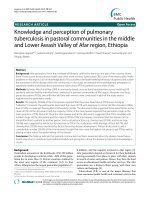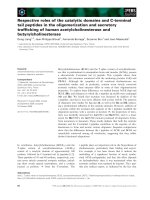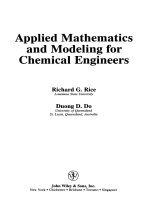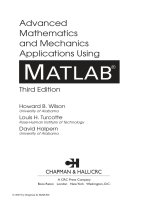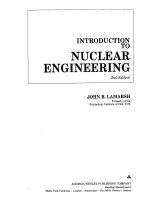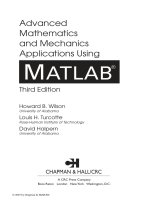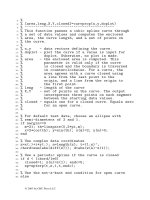North holland series in applied mathematics and mechanics 28 theory of flexible shells
Bạn đang xem bản rút gọn của tài liệu. Xem và tải ngay bản đầy đủ của tài liệu tại đây (14.62 MB, 401 trang )
NORTH-HOLLAND SERIES IN
APPLIED MATHEMATICS
AND MECHANICS
EDITORS:
J.D. ACHENBACH
North western University
B. BUDIANSKY
Harvard University
W.T. KOITER
University of Technology, Delft
H.A. LAUWERIER
University of Amsterdam
L. VAN WIJNGAARDEN
Twente University of Technology
VOLUME 28
NORTH-HOLLAND - AMSTERDAM · NEW YORK · OXFORD · TOKYO
T H E O R Y OF
F L E X I B L E SHELLS
E.L. AXELRAD
Institut für
Mechanik
Universität der Bundeswehr
Fed. Rep.
München
Germany
1987
NORTH-HOLLAND-AMSTERDAM · NEW YORK · OXFORD · TOKYO
©
ELSEVIER SCIENCE PUBLISHERS B . V . — 1 9 8 7
All rights reserved. No part of this publication may be reproduced,
stored in a retrieval system, or transmitted, in any form or by any means,
electronic, mechanical, photocopying, recording or otherwise, without the prior
permission of the copyright owner.
ISBN: 0 444 87954 4
Publishers:
E L S E V I E R S C I E N C E P U B L I S H E R S B.V
P.O. Box 1991
1000 B Z Amsterdam
The Netherlands
Sole distributors for the U.S.A. and Canada:
E L S E V I E R S C I E N C E PUBLISHING COMPANY, INC.
52 Vanderbilt Avenue
New York, N.Y. 10017
U.S.A.
Library of Congress Cataloging-in-Publication Data
Axelrad, E . L . (Ernest L . ) , 1 9 2 7 Theory of flexible shells.
(North-Holland series in applied mathematics and
mechanics ; v. 28)
Bibliography: p. 385
1. Shells (Engineering) 2. Elastic plates and
shells. I. Title. II. Series.
TA660.S5A94
1986
624.Γ7762
ISBN 0-444-87954-4 ( U . S . )
PRINTED IN T H E N E T H E R L A N D S
86-11475
T o A . I . Lur'e
one of those few, whom so many
owe so much in mechanics
PREFACE
Engineers who must cope with problems of thin-walled structures and
their research colleagues have fundamental monographs and textbooks
on shell theory available. But there is next to nothing on "flexible
shells" there. What indeed is meant by this term?
The almost exclusive concern of the shell-theory manuals are shells
designed for strength and stiffness. Analysis of these shells is based
predominantly on two special branches of shell theory, namely, the
membrane and the Donnell-Koiter theories. These are theories of
stressed states which vary, respectively, slowly or markedly with both
surface coordinates.
It is less well known that there is a complementary class of shells and
a corresponding branch of the shell theory, which occupies the ground
between the above classic domains. These are flexible shells, designed
for maximum elastic displacements.
Flexible shells—curved tubes, Bourdon pressure elements, bellows,
expansion joints, corrugated diaphragms, twisted tubes—have been
used in industry for many decades. Their underrepresentation in
shell-theory books is partly due to the striking diversity of shapes and
problems involved (cf. the schemes in Fig. 12 on p. 7 2 ) . By contrast
great effort has been invested in solving individual problems. (Curved
tubes alone were treated in 1911-1985 in over 250 articles.)
The experience thus gained facilitated the perception of the imma
nent feature of small-strain deformation rendering large displacements:
such deformation varies slowly and is nearly membrane-like along one
of the surface coordinates while along the other it can vary intensively
and involves substantial wall-bending. This feature constitutes the
foundation for the specialized theory of flexible shells.
The prediction of stability and the analysis of postbuckling can be
adequately served by the Donnell-Koiter theory also for flexible
shells. However, in contrast to the "stiff" shells, stability and postbuckling are not the sole, not even the main objects of nonlinear
viii
PREFACE
analysis of flexible shells. It requires the specialized theory just men
tioned.
For the buckling analysis, the flexibility causes substantial complica
tion of perturbing both the shape and the stress state by large
precritical displacements. Effective aid is provided here by the localbuckling approach.
The general theory is stated in the vector form. This formulation is
as far as possible coordinate free, facilitating physical insights essential
for complicated (flexible shell) problems. Transition to the component
form is most direct for the orthogonal coordinates sufficient for all
problems considered. There is no need of "exposing the gears of a
machine for grinding out the workings of a tensor" ( J . G . Simmonds).
The equivalence of the vector formulation to the tensor one is briefly
traced (p. 6 7 ) .
Throughout the book the intrinsic theory is used. The evaluation of
displacements has been avoided also for kinematical edge conditions.
This mitigates an obstacle in the intrinsic formulation, one of
the causes of the recent revival of the displacement approach. This
approach has been the object of research of many a distinguished
mechanician. Remarkable progress has been achieved. But the crucial
for applications complexity of the equations could not be overcome,
not even at the price of drastic restrictions on rotations. The intrinsic
approach retains its advantages. These are absolute by large displace
ments (cf. §8.3, Ch. 3 ) .
For both periodic and boundary-value problems, the trigonometric1
series solution in matrix form is widely applied in the book. It remains
one of the most suitable methods, even more so with the advent of
computers. Useful in reducing the partial differential equations to the
ordinary ones, it leads in some cases to closed-form solutions. Of
course, the series method does not replace powerful numerical tools
like direct integration or finite elements with their computer programs.
On the contrary, such numerical studies are complemented by a more
articulate theory. An advance assessment of eventual results can be
particularly helpful in solving a nonlinear problem.
1
Another way is opened by Fast Fourier Transforms. It proved effective in numerical
modelling of semiconductor devices described by highly nonlinear partial differential
equations.
PREFACE
ix
The book contains five chapters. Chapter 1 presents the general
nonlinear theory of elastic thin shells. Despite its conciseness it
includes enough basic theory to make the book self-contained. The
formulation is unconventional in regard to its use of a vector descrip
tion of the shell geometry and of strain, including nonlinear com
patibility equations.
Chapter 2 starts with formulation of the main problems and the
hypothesis of flexible shells (§1). This is followed by the analysis of the
Saint-Venant problems, resulting in the nonlinear Reissner equations
(§2), the linear Schwerin-Chernina system of the axisymmetric
shells under wind-type loading and of curved tubes with forces applied
at the ends ( § 3 ) . Next ( § 4 ) , the general nonlinear shell equations of
equilibrium and compatibility are integrated and simplified with the aid
of the hypothesis of flexible shells. This leads to a solution system
extending the Reissner and Schwerin-Chernina equations to nonsymmetric problems. The analysis also shows the flexible-shell hypothesis
to be tantamount to the semi-momentless model. This model gives (in
§5) another, Vlasov-type resolving system. The rest of Chapter 2 is
concerned with the solution methods of the basic problems.
Chapters 3 - 5 are devoted to applications of the theory.
More space is allotted (Chapter 3 ) to the problems of tubes and
torus shells, which in recent years (since 1973), have acquired promi
nent significance in energy technology. Besides the analysis of "long"
tubes, the nonlinear flexure and buckling is considered for prescribed
boundary conditions. Buckling under external pressure is discussed for
tubes and for torus shells including those with ribs.
The nonlinear flexure of open-section beams is considered in
Chapter 4.
Chapter 5 treats flexible shells of revolution including the crossbending of seamless bellows and the contact effects in welded bellows
due to overloading.
Three remarks on the manner of presentation are in order:
(1) The discussion is concerned mainly with isotropic homogeneous
shells. The possibility of extending the results to orthotropic and
layered shells and to include the effects of thermal expansion is
indicated in Chapter 1, §7 and illustrated by examples in Chapter 3,
§12 and Chapter 4, §4.
(2) The book contains many graphs and some tables as aids to the
χ
PREFACE
evaluation of stresses and displacements. However, the main aim of
the author is to present a system of methods, rather than a list of
recipes.
(3) In Physics, "the more complicated the system, the more sim
plified must necessarily be its theory" (Ya.I. Frenkel). Shells are
complicated systems; flexible shells are among the more intricate of
these. Their analysis is dominated, indeed shaped, by the stratagem of
trimming all that projects beyond the limits of accuracy of the thinshell theory.
In preparing the book the author has drawn on his book Flexible
Shells published in 1976 in Russian.
The book reflects the progress achieved by efforts of many inves
tigators. It grew out of the author's work on problems of interest to
several industrial organizations and from lecture courses given in
Leningrad, Darmstadt and Munich.
The help of friends and associates in programming and computation
is gratefully acknowledged in relevant places of the book.
The author's sincere thanks for valuable discussion and suggestions
are due to Professor F. Emmerling. Appreciation for many improve
ments is expressed to Professor W. Stadler who first read the text and
to Dr. W. Hübner.
The author is grateful to Professor W.T. Koiter for his support.
CHAPTER 1
FOUNDATIONS OF THIN-SHELL THEORY
1. Shell geometry
2. Deformation of the reference surface
4
15
3. Hypotheses of the theory. Shell deformation
22
4. Equilibrium equations
27
5. Elastic energy
32
6. Constitutive equations
36
7. Boundary conditions. Temperature effects
46
8. Static-geometric analogy. Novozhilov's equations
55
9. The Donnell equations and the membrane model of a shell
Commentary
59
65
CHAPTER 1
FOUNDATIONS OF THIN-SHELL THEORY
A closed shell is a body bounded by two surfaces whose overall
dimensions are much greater than distance between the surfaces—the
thickness of the shell wall. If a shell is not closed (as a ball is) there is yet
another bounding surface—the edge surface.
Shell theory is a branch of Mechanics of Deformable Bodies. It is a
practice-oriented, engineering theory. Providing a two-dimensional
representation to three-dimensional problems, the shell theory makes
the analysis immensely more tractable. The reduction is achieved in a
way similar to that of the beam theory. The theory deals with variables
defined only on the reference surface (lying mostly in the middle of the
wall-thickness). The accuracy of the shell theory depends on the shell
being sufficiently thin and also on the mechanical properties of the shell
material and on the load distribution. Only elastic shells conforming to
Hooke's law are considered in the following.
There are several approaches to the formulation of the shell theory.
In this book the theory is derived on the basis of hypotheses. This
axiomatic method goes back to the ground-breaking work of G.
Kirchhoff (on plates) and to the first work on shells by ARON [1]. It is
well suited for an engineering theory. Its relative simplicity and explicit
form are particularly valuable for the nonlinear case. However, the
evaluation of the bounds of applicability of the theory and of its errors is
not possible within the theory's framework set by the hypotheses. The
verification is achieved when the shell theory is evolved from a
three-dimensional theory. After the classic works of Cauchy and
Poisson (on plates), this approach was developed in the investigations
of A . I . Lur'e, E . Reissner, A . L . Gol'denveiser, F . John and others.
This is the main way of verifying an axiomatically evolved shell theory.
4
FOUNDATIONS OF THIN-SHELL THEORY
[Ch. 1, §1
A third approach to shell theory consists of the consideration of a
shell as a two-dimensional continuum supporting moment stresses. The
idea of constructing a model of a shell independent of a threedimensional theory and its simplifications is due to E . and F. C O S S E R A T
in 1909. This approach is exhaustively presented in the work of N A G H D I
[48].
A comprehensive analysis of the development of the foundations of
shell theory may be found in the review of K O I T E R and S I M M O N D S [155].
1. Shell geometry
The form of a shell is defined in a way similar to the description of the
shape of a beam in terms of the shape of its axis. The shell form is
determined by that of the reference surface and by the thickness of the
shell, which may be variable along the shell. (For nonhomogeneous
material of the shell it is expedient to choose the reference surface lying
not in the middle of the shell thickness (present chapter, §6).)
Correspondingly, this section is concerned mainly with the theory of
surfaces. All the information needed to obviate reference to the special
literature is presented. No derivation is omitted or based on any fact
beyond the scope of college mathematics.
1.1.
Coordinates
A point of the shell (M in Fig. 1) is defined by its distance ζ from the
reference surface and by the coordinates of the point m of this surface,
lying on a £-axis normal to the surface and passing through M. The
reference surface is described in terms of the curvilinear coordinates ξ
and η. Each pair of values of ξ and η determines the position vector
r(£, Ύ]) of a single point m of the reference surface.
Points of the surface corresponding to a fixed value of ξ constitute a
line—a coordinate line η or, in short rj-line. Every point of the surface
can be found as an intersection of a £-line and an 77-line. Obviously, all
points of the reference surface correspond to ζ = 0. A point Μ is thus
defined by the three coordinates ξ, η and ζ. When the reference
surface coincides with the middle surface, the two surfaces bounding
the shell wall have equations ζ = ±h/2. The shell-wall thickness may
be variable, defined by h = /z(£, 17).
Ch. 1, §1]
5
SHELL GEOMETRY
FIG. 1. Reference surface and curvilinear coordinates.
The vector equation of the middle surface r = r( TJ) also determines
the directions of the coordinate lines and the differentials of their arc
lengths dsl and ds2 at each point of the surface.
An element of the £-line connecting points ητ(ξ,η) and τηχ(ζ +
άξ, η) shown in Fig. 2 is determined by the tangent vector dr =
(dr/οξ) άξ. The introduction of the unit vectors tx and t2 tangent to the
coordinate lines yields
dr
dr
T (
= atl9
dr
a =
3η
(1.1)
Thus, the lengths of the elements of coordinate lines are determined by
kid£
xt
FIG. 2. Element of £-line (r/ = const.) and tangent vectors tx.
6
[Ch. 1, §1
FOUNDATIONS OF THIN-SHELL THEORY
the parameters a and b,
dsl = α άξ ,
ds2 = b άη .
(1.2)
Usually, and also in what follows, the surface coordinates are chosen
to be orthogonal at every point. For orthogonal coordinates the unit
vectors t1 and t2 are connected with each other and with the unit vector
t3 = n, normal to the middle surface, by the formulas
tlxt2
= n
t2x
n= t
nxt,=t
(1.3)
The undeformed shape of a shell is a particular case of its deformed
(under the applied load) shape. In what follows, the values of parame
ters decribing the geometry of a shell after deformation will be denoted
by an asterisk. The shear deformation of the reference surface makes
the ξ- and 17-lines (their unit tangent vectors t* and t2) nonorthogonal to
each other even when they are orthogonal before the deformation. This
makes in the following some relations of the nonorthogonal coordinates
unavoidable.
Relations ( 1 . 1 ) and ( 1 . 2 ) remain valid for the r*,
a*, b* and
ds*, describing the deformed shape of the shell. During an arbitrary
deformation of the shell, the coordinates ξ and η of any point remain
unchanged.
1.2.
Curvature
of
surfaces
Consider shape of a surface in the vicinity of a point on it. The
curvature of the surface can be measured in terms of rotation of a
tangent plane moving along the surface. The position of the plane is
determined by the vector n, which is normal to it. To measure also
rotation of the plane around the normal n, we must relate the plane at
a point of the surface ra( ξ, η) to some material linear element of it. We
choose for this an element of the surface (ids) bisecting the angle
between the coordinate lines as shown in Fig. 2. Thus, the position of
the tangent plane is identified in terms of the two unit vectors
n
= /,x/.
t = (tl + t2)/\tl
+
t2\.
(1.4)
Ch. 1 , § 1 ]
7
SHELL GEOMETRY
(Clearly, the shear deformation makes an angle between two linear
elements different from the value it had before deformation. Thus, the
angular displacements of different linear elements at a point of the
surface are not equal to each other. It may be verified that the angular
displacement of the vectors η and t into a position it* and /* =
{i% + t*)l\t\ + 1 * \ is equal to the rotation at a point of a deformable
body, as defined in theory of elasticity.)
We introduce two vector parameters Ιί^ξ, η) and fc2(£, η) of surface
curvature, defining kx άξ + k2 άη as an angle (άΦ) between the
tangent planes at points τπ{ξ,η)
and m ' ( f + άξ, η + άη) of the sur
face. The vector kx (or k2) is a measure of the curvature of the
surface, observed in moving along the £-line (or η-line).
The geometric meaning of the curvature vectors kx and k2 becomes
clearer with their component representation
kx
nx L
— =
a
nx t?
- Η
R,
n
k?
Η
Rl2
nxt,
lP
'
b
nx U
-+
— =
R21
n
Η
R2
p2 '
„ ^
Π 5)
v
'
;
According to the definitions of kx and a the value of 1/R1 is equal to that
angle of rotation of the normal vector n in the plane of n and tx (Fig. 1 ) ,
which corresponds to a unit distance along the f-line. This means: Rx is
the radius of curvature of the intersection line of the surface with a plane
passing through n and tangent to the f-line. In other words, \IRX is the
curvature of the normal section of the surface along the coordinate line
ξ. The variable 1/R2 has a similar meaning for a normal section along
the Tj-line.
The meaning of the variables RX2 and R2X is illustrated in Fig. 3.
For this example, the normal section curvatures 1/Ri are equal to zero
and the coordinate lines ξ and η are locally straight. The coordinates
are also orthogonal making rotation of n with t identical to that of n
with t2 and tx. According to the definition of kx and Fig. 3, in this case
kx άξ = -tx dsx/RX2.
With the shift ds2 = b άη along the other coordi
nate line the triad n, tx and t2 turns by an angle k2 άη = t2
as2IR2X.
Determining the distance denoted in Fig. 3 by δ through each of the
two angles results in the equality RX2 = R2X (proved in §1.3 for the
general case of local shape of a surface). The variable 1/RX2 = 1/R2X is
called the twist of the surface.
The remaining curvature parameters pi determine the radii of the
8
FOUNDATIONS OF THIN-SHELL THEORY
FIG.
3. Parameters 1/R12
and 1/R21
[ C h . 1, §1
giving the twist o f the surface.
in-plane or g e o d e t i c curvatures
of the coordinate lines ξ and η. Indeed,
kx asx is an angle of rotation for the vectors n and t in turning through
the distance d s x = α ά ξ . The component n d s l / p 1 indicates the rotation
around the normal (in the tangent plane). When the coordinates ξ and η
are orthogonal, the tangents of the coordinate lines turn by the same
angles as the pair n and t, in particular by n d s 1 / p 1 . The curvature of the
projection of the ξ-line on the tangent plane is thus equal to the quantity
1/pj = \n
ds1/p1\/ds1.
The curvature vectors kx and k2 render formulas for derivatives
with respect to the coordinates ξ and η for the basis vectors.
Consider first the derivatives for an auxiliary unit vector v( ξ, η)
directed at any point of the surface at some fixed angles to n and t. The
definition of kx means in fact that k1 ά ξ determines the angle between
the vectors ν in two adjacent points πτ(ξ, TJ) and ητλ(ξ + df, 17). This
amounts to the relation
V( ξ + άξ, η) = V( ξ, η) + ^άξΧ
ν{ ξ, η)
(1.6)
or to the formula
ν
Λ
= ^ ν
= ^ Χ ν .
(1.7)
Naturally, there exists a similar formula for the other derivative:
ν2 = dv/θη
= k2 x v. The formulas for the derivatives remain valid for
the particular cases of ν = tt and ν = n. Thus,
Ch. 1, §1]
SHELL GEOMETRY
vj = k j X v ,
f i f /. = *;. x f,.,
n
t j
9
=kjXn
( / , / = l , 2 ) . (1.8)
(If the angles between the vectors tx and t2 vary with the coordinates ξ
and τ/, the derivation formulas for tx and f 2 are, naturally, different
from that for t or ν [197].)
Surface-geometry
relations
Four vectors describing the local shape of the surface have been
introduced thus far: k 1 9 k 2 , r Λ = atx and r 2 = bt2. The four variables
are related by two vector equations.
The first of the equations is obvious. Any vector function r(£, TJ)
defining a continuous smooth surface satisfies the relation
Γ
=
,12
Γ
,21 ·
The corresponding three scalar equations are particularly simple for
the orthogonal coordinates ξ and 77; they can be written with the aid of
(1.1), ( 1 . 8 ) , (1.5) and ( 1 . 3 ) in the form
± =- ^
Pi
b '
L =t l
a '
p2
J
_
fl12
=
J
_
R21
)
The second of the mentioned vector relations is rendered by the
condition
V
,12
=
V
,21
>
which must be fulfilled for the vector v{ ξ, η) having at any point of a
smooth surface a fixed position in relation to the tangent plane at the
point.
Applying the differentiation formulas (1.8) to the equation v l 2 —
v21 = 0 and using the triple-product relation Ax (B x C) + Β x (C x
A) + C x ( A x Z ? ) = 0 transforms the left-hand side of the equation to a
product of a differential expression and the vector v. Since ν is
arbitrary, the cofactor must be equal to zero, resulting in
kx
2
k 2 j ~h k x x k 2 — 0 .
(1.10)
(
1
9
10
FOUNDATIONS OF THIN-SHELL THEORY
[Ch. 1, §1
This equation is equivalent to three scalar ones which for orthogonal
coordinates ξ and η are
(1.11)
(1.12)
The relations (1.11) bear the name of Codazzi, while (1.12) is that of
Gauss.
It is proved in the next section that for any surface there exist
orthogonal coordinates ξ and 77, such that at any point of the surface
1/R12 = 1/R21=0.
These coordinate lines coincide with the lines of
curvature of the surface. That is, one of the normal curvatures l/T^j and
1/R2 is the maximum; the other, the minimum of curvature of normal
sections at a point of the surface. A simple procedure for determining
two (orthogonal) directions for the lines of curvature is given in present
chapter, §5. However, in all the cases discussed in this book, the lines of
curvature are easily determined by inspection.
A feature of the curvature line, which is useful in identifying it,
follows directly from the expansions of kt (1.5): along a line of
curvature (1/Rl2 = 0) the normals n turn only in the plane tangent to
FIG. 4. Twisted shell element
(1/R12^0).
Ch. 1, §1]
11
SHELL GEOMETRY
the line. An example of the opposite situation, in which an element of
a shell is twisted, viz., l / i ? 1 2 7 ^ 0 , is presented in Fig. 4.
1.4. Determination
of curvature.
Surfaces
of
revolution
Consider two ways of determining the values of Rt, Rl2 and p f . First,
having (for the chosen orthogonal coordinates) expressions of *,(£, η),
their derivatives may be found by direct differentiation. The subsequent
use of (1.8), ( 1 . 5 ) and ( 1 . 3 ) yields
= -fl
f l
-n,
b_ = _
2
2
'>
R2~
1
— t2 χ
A i
· Λ
-
(1.13)
.
a
Alternatively, the right-hand sides of the formulas may be nΛ · tx, n 2 · t2
and w j · t2la.
Another possibility, existing in many cases, is the direct determin
ation of the vector curvature parameters kx and k2 from their geometric
definitions, by inspection.
Let us apply the two methods to a surface of revolution—a surface
developed by a plane 17-curve {meridian 77-line in Fig. 5 ) rotating
around an axis (denoted by ζ in Fig. 5 ) . In this rotation, each point of
the 77-curve constitutes a parallel circle, a £-line. Take b = const.,
making οη equal to the length of the meridian measured from a chosen
parallel η = 0. For the coordinate ξ, take the polar angle to the
FIG. 5. Surface of revolution developed by a meridian (ξ = const.).
12
[Ch. 1, §1
FOUNDATIONS OF THIN-SHELL THEORY
meridian plane of a point considered. This means sx = ϋξ, a = Ζ?(τ/).
The cylindrical coordinates R and ζ will be used besides ξ and η.
An inspection of Fig. 5 gives expressions for tx, t2 and n in terms of the
unit vectors i, / and tz of the Cartesian system x, y and z, which are
constant, independent of ξ and 77,
tl =j cos ξ — i sin ξ ,
t2 = tz cos a — tK sin α ,
n; = f z sin α + f Ä cos a ,
6 cos a = άζ/άη ,
f Ä = f cos f + / sin f ;
(1.14)
6 sin α = — d j R / .
The unit vector tR and the angle α (η) are shown in Fig. 5.
Substitution of the expressions for tx, t2 and n in terms of ξ and η and
of ϊ, 7 and tz into (1.13) gives
1 _ cos α
1 _
da
1 _
1
_
With a = R, b = const., formulas ( 1 . 9 ) give
- = --^-=sina,
PI
b di)
—=0.
p2
(1.16)
Clearly, 1/R1 and \lpx are components of the curvature 11R of the
f-line, which is, of course, a parallel circle (Fig. 5 ) .
The absence of twist and of in-plane curvature of the 17-line ( 1 /
R12 = 0, l / p 2 = 0 ) is an obvious consequence of this line lying in the
symmetry plane of the local form of the surface.
The values of the curvature parameters in (1.15) and (1.16) follow
more directly from values of kx and k2, determined by inspection
of the angles kx άξ and k2 drj between triads tx, i 2 and n at points located
on the coordinate lines at distances R άξ and b άη, respectively. Thus,
Fig. 5 and definitions of k19 k2 and tz result in
(
Ί
+
'2
. "W
x r ^ r I ^ J ^
,
ά ξ
~r '
z
( Ί
\-ΊΓ
-μ
+
2
'2
^
.
+
n\
J )
2
da
άΎ]
=
~T '
l
Equating the three components of both sides of these equations gives
the same six formulas for Ri9 Rl2, R21 and pt as in (1.15) and (1.16).
Ch. 1, §1]
SHELL
13
GEOMETRY
1.5. Local-geometry parameters for different coordinate systems
A full picture of the shape of a surface around a point can be provided
by a survey of the normal curvature and the twist for all possible
directions of the coordinate lines. Fortunately, this picture can be
deduced from the values of Rx, R2r Rl2, R2X, a and b known for one
for
coordinate system ξ, η. The values of the parameters (Rx, R2J...)
a
α
any coordinate system ξ , η turned in relation to ξ, η through an angle
a can easily be calculated. The corresponding formulas follow directly
from relations
α
kx άξ = ^άξ
a
+ k2 άη,
dr= txa
α
άξ = txa άξ + t2b άη .
(1.17)
a
The variables kx, t\ and a , introduced here, are the values of the kx,
α
α
tx and a for the coordinates ξ and η , shown in Fig. 6. The second of
α
equations (1.17) is obvious. The first becomes so if we recall that k" άξ
is the angle between tangent planes at the points m{ξ, η) and m 2 ( f +
d£, η + άη). The angle has the same value when the tangent plane goes
α
from point m to m2 not along the line ξ but along the component
segments of the lines ξ and η (Fig. 6 ) .
For orthogonal coordinates, there follows from (1.17),
kx
-77
a
=
kx
k2
—c
+
—s
,
a
αάξ
c = cos et — α"a άξ
„t α ,
b άη
s = sm a = αa ύξΛί.α.
(1.18)
With the obvious from Fig. 6 representation
ίχ
tXC
12S ,
+
t2 = t2c
α
txs
α
FIG. 6. Coordinates ξ, η and £ , η .
14
[Ch. 1, §1
FOUNDATIONS OF THIN-SHELL THEORY
and an expansion of k\ similar to that for kx in (1.5)
a
a"
R 12
p"
R",
V
1
22
) x
equating of components on both sides of relation (1.18) results in
1
K?
c
=
^
2
es
+
Ä ^
2
es
+
Ä27
s
+
Ä 2" '
1 _ c
r J
2
2
es
es
s
2
~ " R i ~ ' r [ ~
(1.19)
These formulas give normal-section curvature and twist for any system
of orthogonal coordinates. The extremum condition
^-—=0
(1.20)
with \IR\ from (1.19) yields the angles ax and a2 = ax + ττ/2 from the
original ^-direction to the planes of maximum and minimum normalsection curvature. The extremum condition happens to be identical to
the equation 1/RX2 = 0.
Thus, for any given surface there exist two mutually orthogonal
directions of extremum normal-section curvature at any point of the
surface. The lines passing through each point of the surface in these
directions constitute a net of lines of curvature. When these lines are
used as coordinate lines, the twist is equal to zero (1/R12 = 1 /R21 = 0 ) .
From the equation d(l/R^)/da
= 0 or from 1/R"2 = 0, we obtain
t a n 2 « ! = t a n 2 a 2 = ur'^i/r
>
(
L 2 1
)
as the formula for the angles between a £-line and the lines of curvature
at a point.
Of course, (1.19) indicate that l/Ri and l//? i ;- constitute a twodimensional second-order tensor. The same follows from the relation
2
2
(1.17) for a , b and
abtx-t2.
A graphical representation of the curvatures in all possible normal
sections at a point of a surface, illustrating local shape of a surface,
follows directly from (1.19). It is a curve in an xy-plane with [x y] =
Ch. 1, §2]
VR^[c
DEFORMATION OF THE REFERENCE SURFACE
15
s], defined by an equation following from (1.19)
This curve is called Dupin's indicatrix. The form of the indicatrix does
not depend on the individual values of Ri and R129 but on
Consequently, these two parameters (called the Gaussian and the
mean curvature) are independent of the choice of the coordinate lines
ξ and η. The in variance is, of course, deducible from (1.19) and the
similar formulas for R2 and R2l.
(For K>09 K<0or
K = 09 the indicatrix is an ellipse, a hyperbola or
two parallel lines. Examples of corresponding shapes are an ellipsoid, a
hyperboloid and a cylinder surface.)
2. Deformation of the reference surface
2.1.
Deformation
parameters
1
The local shape of the surface after deformation
is described by new
values k*9 k*, r*l = a*t* and r* 2 = b*t* of its four vector parameters,
its overall shape—by the new vector function r* changed by the
displacement u according to
(1.22)
Each pair of coordinate values ξ9 η designates some "material particle"
of the surface. These (Lagrangian) coordinates of a particle remain
unchanged by any deformation of the surface.
In describing the local deformation of the surface it is natural to
use characteristics (strain resultants of the shell), directly reflecting
the change of the four geometry parameters from ki9 r . to k*9 r*r
Introduce strain resultants Kt and ef. in the simplest way compatible
with the requirement that the strain resultants be equal to zero at any
1
Equivalence
of the following vector description of strain and the classical
description is discussed on pp. 6 7 - 6 8 .
tensor
16
[Ch.
FOUNDATIONS OF THIN-SHELL THEORY
1,
§2
point where the shell is not deformed,
k2 — k 2 R H~ i>K2 ,
k* = k l R + ακχ ,
r
r*i = ( , i ) * +
α
ε
ι>
r
( 1 ), 2 3
% = 0 \ 2 ) K + be2 .
The values of kiR and ( r j ) R must be equal to k* and r* f at any point of
the surface where there is no local deformation. This means that the
variables kiR and (r i)R describe the initial, undeformed local shape of
the surface. They merely take into account the local rotation of the
surface, i.e. its angular displacement, caused by a deformation of the
surface as a whole. Components of the vectors kiR and ( r A ) R can be
made equal to the components of the parameters ki and r t of the initial
shape of the surface, provided a special basis is used for the kiR and
(r ·)*. This basis is composed of unit vectors t[, t2 and n* coinciding
with the tx, t2 and η initially but moving with the tangent plane during
2
any deformation of the surface . This rotated basis remains in the
same position relative to the pair n* and t* as was the initial basis with
respect to η and t. As illustrated in Fig. 7, the angles between the
tangent vectors of the coordinate lines (t*) and the t\ are equal to a
half of the shear angle y. The t\ are easily expressed in terms of the t*.
In the case of small strain (|γ| <^ 1), they become
'ί = '
ί - | ' 2 >
4=*
(1-24)
2 - | ' ϊ ·
Besides being the unique basis for the expansions of the kiR and (r t ) R ,
the vectors t[, t2 and #i* have the advantage of being independent of the
FIG. 7 . Rotated basis t'
2
The use of the rotated basis is actually a counterpart to the polar decomposition (e.g.,
[ 1 3 3 , p. 1 4 6 ] and N . A . A L U M A E , Prikl. Mat. Mekh.
13 ( 1 9 4 9 )
95-106).
Ch. 1, §2]
17
DEFORMATION OF THE REFERENCE SURFACE
shear deformation. In particular, they retain the orthogonality if the
coordinates ξ and η are orthogonal before the deformation. The
following expansions of the vectors introduced in (1.23) define the
scalar parameters of the deformed-surface geometry and strain:
[*i
*1* * l = n*XfT—
(rx)R
= at[,
—
Λ
\
Kl
Η
]
+
K
Λ
n*xt'
1
R12
R[2
1
(»*χ*ί = 4 , . . . ) ;
(1-25)
J
r*x = a*t* ,
ε
ε
=
\
Μι
ΐ2^2
+
(1
2
a
b)
.
Expansions for the remaining parameters k2, . . . are obtained from
(1.25) when the indices 1, 2 and 12 and the parameter a are replaced
by 2, 1, 21 and b, respectively. This is indicated by the symbol
(1 2 a b).
With the definitions (1.25) and expressions of the t* in terms of t\
according to (1.24), one obtains the formulas for strain resultants
1
R\
1
1
R'12
/?i'
1
1
R12'
ε
2
=
-Γ
Ai
~
1
>
J _
_
Pi
1
(1 2 ) ;
Pi
ε
ε
ΐ2
21
2'
(1.26)
(1.27)
Similar formulas are easily written out for large strain.
The actual curvature and twist of the deformed surface
(1/R*,1/R*2)
can be expressed with the aid of the foregoing formulas and of
expansions
«*
n* x t
R*
+
n* X t%
+ ΤΪ
R*2
lP
(12
a b)
(1.28)
in terms of the strain resultants κ / 5 τϊ and λ;. But the expressions are
not as simple as those for \IR\, . . . from (1.26).
The formulas, derived directly from (1.28) and (1.26) for γ = 0,
[R* R\ P i ] = (l + )[/?i R[ p[]
2
are used in Chapter 2, §2.
ei
2
9
(1.29)
18
2.2.
[Ch. 1, §2
FOUNDATIONS OF THIN-SHELL THEORY
Compatibility
equations
As long as the surface retains its continuity during deformation, the
deformed-shape parameters k* and r*- satisfy the Gauss-Codazzi
equation (1.10) and r * 1 2 = r * 2 1. This and the expressions (1.23) imply
two vector compatibility equations for the four strain resultants K f
and er
To derive the equations, we need the derivatives of kiR and ( r j ) R with
respect to ξ and η. According to the definition of t\ (as rotating to
gether with * * ) , the derivatives of /t* and t\ are determined by ( 1 . 8 ) , in
which the ki are now replaced with ft*,
[n* *;
= * ; x [ n * t[ t'2}.
(1.30)
Consider the deformation of the surface at a point m. The use of the
tangent plane at m as a reference plane for the displacements results in
t\{m) = t^m). Hence, the relations (1.23) become
k*x(m) = kx(m) + aKx{m)
,
k*{m) = k2(m) + bK2(m)
.
(1.31)
With this, the derivative formulas (1.30) are transformed to
[n* t[ t'2]x = [n tx t2\x
+ ακ x [n
χ
tx t2]
(1 2 a
b).
Now, differentiating each term in the expansions (1.25) as a product
of a vector and a scalar yields
[*** (r ,•) J . i = ft Γ J . i
+
«ι
x
Λ Ά
(1 2 A 6 ) .
(1.32)
Insert the expressions (1.23) into equation (1.10), presented for the
deformed shape of the surface as k\2 - k2 x + k* x A:* = 0, and into
T he
u se
r
r
* i 2 =
*2i°f
derivative formulas (1.32), equations
(1.10), rX2 = r2X and finally (1.31) results in the two compatibility
equations [197]
(ακχ)
ε
2
- (bK2)
Ο ι),2 ~
x
+ a b K x x κ2 = 0 ,
(^ ),i ~
2
xκ
2
-
^x
=0.
^' ^
3 3
The equations are written here in the general form. The tangent plane at

